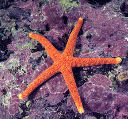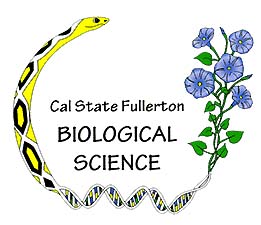








 Return to Honors 301T Home Page
Return to Honors 301T Home Page
Copyright © 2002-2003 D.J. Eernisse. All Rights Reserved.
Phylogeny Part 1 (Review): CLADOGRAM
CONCEPTS AND TERMS:
Cladogram Terminology: Start with some basic
definitions of terms such as node and branch.
Sister Taxa: Learn what a sister taxon is and
why recognizing them will help you with all of the following steps.
Cladogram Styles: Examples of the same cladogram
drawn in different styles and orientation.
Rotate at a Node: Are the two cladograms identical,
merely rotated at nodes, or are they different topologies?
Polytomies:
Are they "hard" or "soft" and how do they relate to strict consensus estimates?
Using Cladograms
Phylogeny Part 2: Using Cladograms
Welcome to the online Cladogram Exercise 2 Web site.
This online assignment will introduce you to how phylogeneticists come up with
their best supported cladograms and how they use them to interpret patterns
and processes of evolution. The links immediately above are provided for your
review and will bring you back to Cladogram Exercise Part 1. Use the browser's
"Back" button to return here. Your feedback
is valuable and encouraged.
Read the instructions below and then
click on the Cladograms Summarize Evolution
link to start the Phylogeny Part 2 Exercise. There may be one or more additional
phylogeny exercises in coming weeks that will focus on parts 3-7. Note that
no scantron is needed for Part 2.
2. Cladograms Summarize
Evolution: A cladogram can be used as a roadmap to the evolutionary history
of a group.
 Parts
3-7 Under Construction
Parts
3-7 Under Construction
3. Data for Cladograms: Introduction to how observations
of similarity are compiled in the form of a character matrix.
4. Types of Data: Emphasizing discrete (not continuous) character states;
exploring morphological and molecular data sets.
5. Special Similarity: Distinguishing types of similarity - the contrasting
notions of synapomorphy and homoplasy.
6. Parsimony Criterion: How one or more trees is supported as the "best"
tree for a certain data set.
7. Interpreting Character Evolution: Interpreting the pattern of character
evolution depends on which phylogeny is supported.
How to turn in Part 2 of this Web assignment.
- Use a simple numbered list numbers corresponding to the cladogram questions
(CQ) as numbered, starting with CQ1 here.
- Unlike Part 1, the answers here will be fill-in-the-blank or short answer.
- You must turn in a hard copy version of this assignment in class; please
remember to put your name on it.
- I will base the date turned in on when I receive the hard copy; the due
date is no later than the posted due date, at the beginning of class.
- Late assignments will only be accepted for full credit if you can
document a valid excuse.
- Late assignments, if unexcused, will still receive half credit, so late
is better than not turning in the assignment.
- Please feel free to work together with your classmates but every student
needs to turn in their assignment separately.
- This assignment is worth 14 points total (2 points per question, CQ1-CQ6,
plus 2 points for responding with feedback after you answer the questions
about what you liked or found confusing about this assignment, or how it compared
to the first one).
- E-mail Prof. Eernisse at deernisse at fullerton dot edu
if you find problems with these instructions (remember to include your name
and email address).
Feedback on particular questions that confused you are welcome!
Email feedback to deernisse at fullerton dot edu
Return to Honors 301T Home Page
This website development began on July 1, 2002 and was last modified
on Sept. 17, 2007.
 CSU Fullerton, Biological
Science Home Page
CSU Fullerton, Biological
Science Home Page


















 Return to Honors 301T Home Page
Return to Honors 301T Home Page
![]() Parts
3-7 Under Construction
Parts
3-7 Under Construction
 CSU Fullerton, Biological
Science Home Page
CSU Fullerton, Biological
Science Home Page